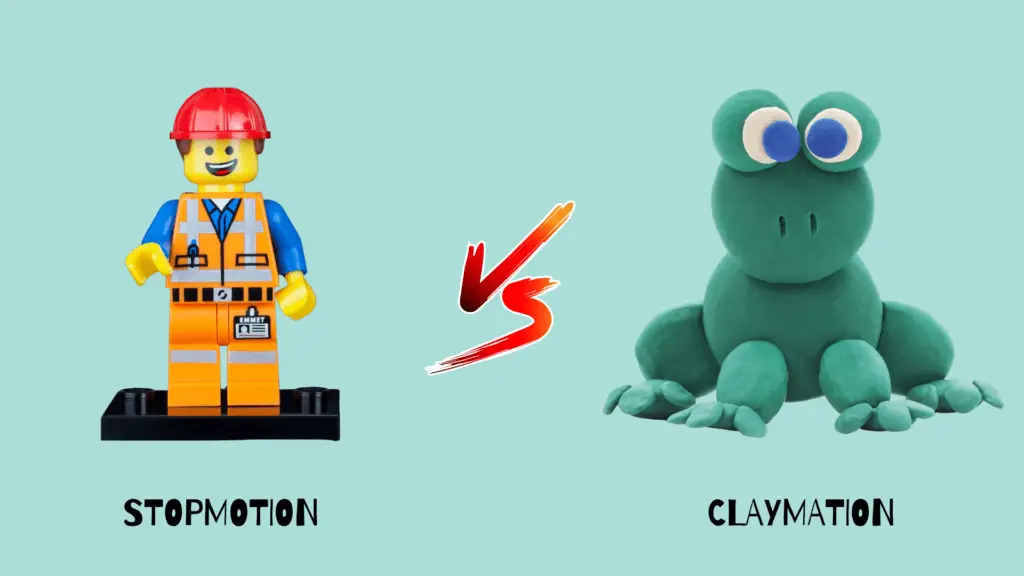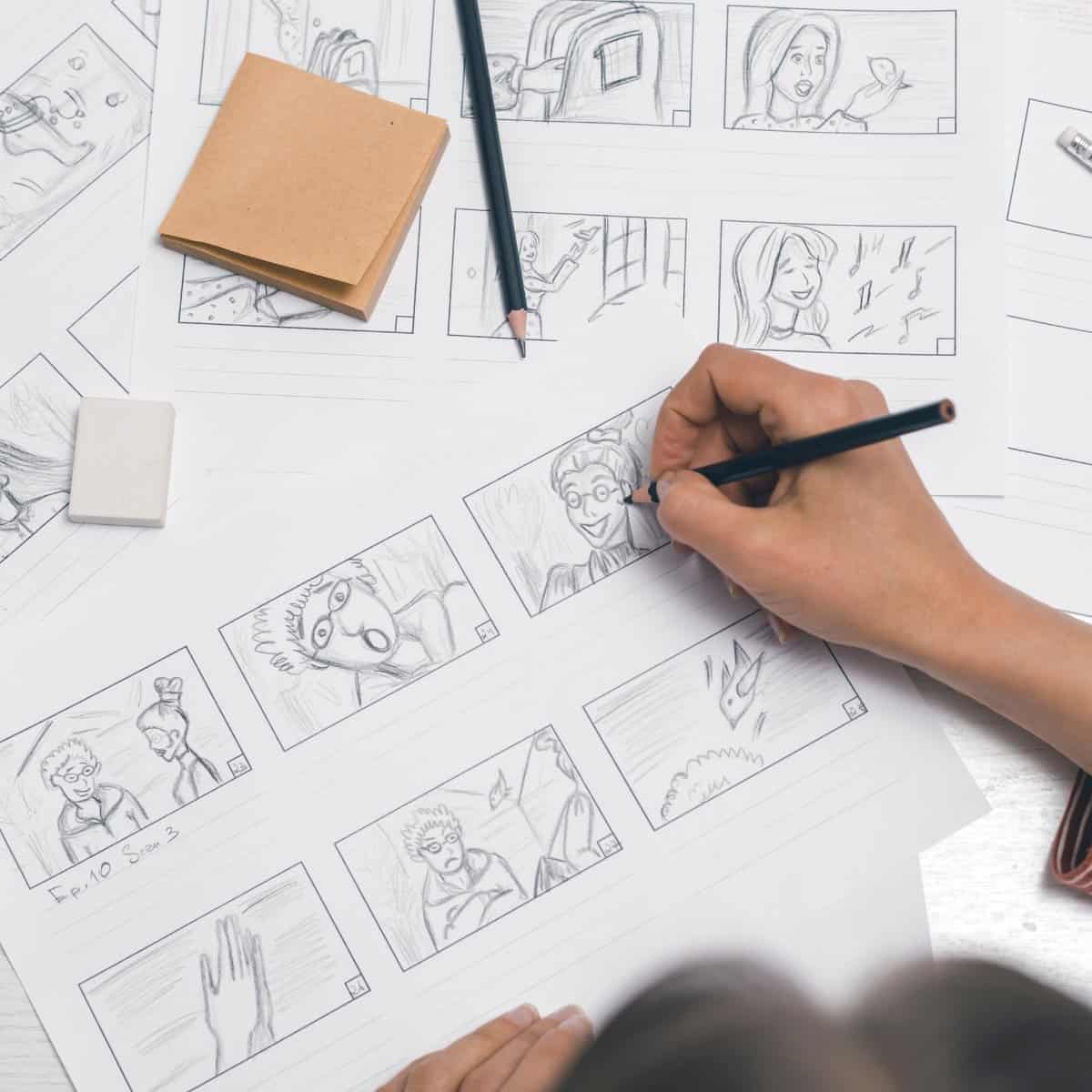Claymation vs stop motion | What is the difference?
Stop motion and claymation are undoubtedly two of the most labor-intensive and time-consuming forms of animation.
Both require equal attention to detail and have been out there for roughly the same time.

In a nutshell:
Stop-motion animation and claymation are essentially the same. The only difference is that stop motion refers to a broader category of animations that follow the same production method, while claymation is just a type of stop motion animation that features explicitly clay objects and characters.
In this article, I’ll be drawing a detailed comparison between claymation and stop motion, right off the basics.
In the end, you’ll have all the knowledge you need to see which one suits your purpose and tastes better.
In this post we'll cover:
What is stop motion animation?
Stop motion is all about moving inanimate objects, capturing them frame by frame, and then arranging the frames chronologically to make an illusion of movement.
A typical stop motion animation contains 24 frames per second of the video.
Unlike traditional 2D or 3D animation, where we use computer-generated imagery to create a particular scene, stop motion takes the help of physical props, objects, and materials to model the entire scene.
A typical stop motion production flow begins with scene modeling with physical objects.
Getting started with your own stop motion storyboards
Subscribe to our newsletter and get your free download with three storyboards. Get started with bringing your stories alive!
We'll only use your email address for our newsletter and respect your privacy
Each character in the animation is made with their specified facial expression and placed accordingly to the script. Afterward, the set is lit and composed for the camera.
The characters are then adjusted moment by moment according to the flow of the scene, and each movement is captured with the help of a high-quality DSLR camera.
The process is repeated for every moment the objects are manipulated to create a chronographic set of pictures.
When changed in rapid succession, these pictures give an illusion of a 3D movie produced entirely through simple photography.
Interestingly, there are many types of stop motion animation, including object animation (the most common one), clay animation, Lego animation, pixelation, cut-out, etc.
Some of the most iconic examples of stop motion animation include Tim Burton’s The Nightmare Before Christmas and Coraline, and Wallace & Gromit in The Curse of Were-Rabbit.
This last movie from Aardman productions is a favorite of many, and a classic example of claymation:
What is claymation?
Interestingly, clay animation or claymation isn’t an independent type of animation like 2D or 3D.
Instead, it’s a stop-motion animation that follows the traditional animation process of a typical stop motion video, however, with clay puppets and clay objects instead of other types of characters.
In claymation, the clay characters are made over a thin metal frame (called an armature) from a malleable substance like plasticine clay and then manipulated and captured moment-by-moment with the help of a digital camera.
Like any stop-motion animation, these frames are then arranged in a successive order to create an illusion of movement.
Interestingly, the history of claymation dates back to the invention of stop-motion itself.
One of the first-ever clay animation films that have survived is ‘The Sculptor’s Nightmare’ (1902), and it is arguably one of the first stop-motion videos ever created.
Anyways, clay animation didn’t get much popularity among the masses until 1988, when films like ‘The Adventures of Mark Twain’ and ‘Heavy Metal’ were released.
Since then, the film industry has dropped a lot of blockbuster clay animation films at the box office, including Coraline, ParaNorman, Wallace & Grommit in The Curse of the Were-Rabbit, and Chicken Run.
Different types of claymation
Generally speaking, claymation also has many sub-types based on the technique followed during production. Some of them include:
Freeform clay animation
Freeform is the most basic type of clay animation that involves changing the shape of clay figures as the animation progresses.
It could also be a particular character that moves throughout the animation without losing its basic shape.
Strata-cut animation
In strata cut animation, a huge bread-like loaf of clay is used that is packed up with varying internal imagery.
The loaf is then cut into thin slices after each frame to reveal the internal images, each a bit different than the previous, giving the illusion of movement.
This is a very difficult type of claymation, as the loaf of clay is less malleable than clay puppets on an armature.
Clay-painting animation
Clay painting animation is another type of claymation.
The clay is placed and arranged on a flat surface and is moved just like wet oil paints, frame by frame, to make different image styles.
Claymation vs stop motion: how are they different?
Claymation follows just about the same as stop motion in production, technique, and the overall procedure.
The only distinguishing factor between stop motion animation and claymation is the use of materials for its characters.
Stop motion is a collective name for many different animations that follow the same method.
Thus, when we say stop motion, we could be referring to an array of animation types that could fall into the category.
For example, It could be an object motion, pixelation, cut-out motion, or even a puppet animation.
However, when we say clay animation or claymation, we refer to a specific type of stop motion animation that is incomplete without using clay models.
Unlike solid Lego pieces, puppets, or objects, claymation movie characters are designed over a wired skeleton covered with plasticine clay to make different body shapes.
In other words, we could say that stop-motion is a broad term that covers just about anything that follows a specific production method and stop motion claymation is one of its many types, with particular reliance on the use of clay.
Thus, stop-motion is a collective term that can also be used for claymation interchangeably.
Learn more about all the things you need to make claymation movies here
As mentioned, claymation is just one of the many types of stop motion animation that follows the same production process as other stop motion films.
Thus, the process doesn’t necessarily “differ” but has one additional step when it comes to claymation.
To explain it better, let’s get into the details of making a typical stop motion animation and where it correlates and differs from stop motion animation:
How making stop motion animation and claymation are the same
Here’s where stop motion and claymation generally follow the same making method:
- Both types of animation use the same equipment.
- Both follow the same method for scriptwriting.
- All stop motion animations generally use the same set of ideas, where the background complements the overall theme.
- Both stop motion and clay animation are produced through frame capture and object manipulation.
- The same editing software is used for both types of animations.
How making stop motion animation and claymation are different
The basic difference between stop motion animation and claymation is the use of materials and objects.
In general stop motion, the animators can use puppets, cut-out figures, objects, legos, and even sand.
However, in claymation, the animators are only limited to using clay objects or clay characters with skeletal or nonskeletal structures.
Thus, this adds up a few differentiating steps that give claymation a unique identity.
Additional steps in creating a claymation video
Those steps are explicitly related to creating clay characters and models. They include:
Choosing the clay
The first step in making any great clay model is to choose the right clay! Just so you know, there are two types of clays, water-based and oil-based.
In professional quality clay animation, the most prevalently used clay is oil-based. Water-based clays tend to dry out quickly, resulting in the models cracking upon adjustments.
Making a wire skeleton
The next step after choosing the clay is making a properly wired skeleton with arms, head, and legs.
Usually, a malleable wire-like aluminum is used for to create this armature, as it bends easily upon manipulating the character.
This step can be avoided by creating a character without limbs.
Making the character
Once the skeleton is ready, the next step is to knead the clay consistently until warm.
Then, it is molded accordingly to the shape of the skeleton, working from the torso outward. After that, the character is ready for animation.
Which one is better, stop motion or claymation?
A considerable part of this answer comes down to the purpose of your video, your primary target audience, and your personal preference since both have their unique pros and cons.
However, with all factors considered, I would give stop motion a clear edge over claymation for some apparent reasons.
One of these would be the broad set of options stop motion animation provides you with compared to claymation; you aren’t limited to modeling with just clay.
This stop motion is highly versatile and enables it to be used for several purposes.
Additionally, it takes just the same effort, time, and budget as any typical claymation, making it even more preferable.
Arguably, claymation is also one of the hardest forms of stop motion. So if you are a beginner, it might not be the best form to start with.
However, if you target your ad or video towards a specific audience, let’s say, millennials who grew up watching claymation, then claymation could also be a better option.
Since modern marketing campaigns are primarily emotion-driven, claymation could be a more practical option as it holds the power to awaken nostalgia, one of the most powerful emotions to connect with your prospects.
Also, since claymation is so tricky, it can of course be an amazing and creative challenge to work with.
As director Nick Park puts it:
We could have done the Were-Rabbit in CGI. But we chose not to because I find with traditional (stop-motion) techniques and clay there is a certain magic that happens whenever the frame is hand-manipulated. I just love clay; it’s an expression.
And although difficult to make, the tools needed to get started with claymation videos are quite budget-friendly, so it could still be a good entry point into the world of stop motion.
Did you know Peter Jackson, award-winning director of The Lord of the Rings trilogy, made his first films when he was only 9 years old, and the main character was a clay dinosaur?
In the simplest words, both are equally effective in their own right.
Using either claymation or other types of stop motion is entirely conditional. You must keep your target audience in front of you as you consider your options.
For example, Gen-Z won’t enjoy a stop motion claymation video as millennials.
They are used to more fun, quirky, and expressive mediums like 3D, 2D, and traditional stop motion animations that include the use of Legos, etc.
Conclusion
Stop motion animation is a great way to show your creativity and bring your stories to life.
It can be tricky to get started, but with the necessary materials and some practice, you can create incredible videos that will amaze your friends and family.
In this particular article, I tried to draw a comparison between an ordinary stop motion video and claymation.
Though both are great, they have a very different feel and watching experience, with an appeal that is very audience-specific, irrespective of the topic.
Which one should you choose to show your creativity to the world? That comes down to your taste and target audience.
Hi, I'm Kim, a mom and a stop-motion enthusiast with a background in media creation and web development. I've got a huge passion for drawing and animation, and now I'm diving headfirst into the stop-motion world. With my blog, I'm sharing my learnings with you guys.
